Branded To Kill, 1967, directed by Seijun Suzuki, written by Hachiro Guryu, Takeo Kimura, Chusei Sone, and Atsushi Yamatoya.
Any country with a developed film industry makes two types of movies: export films designed with world markets in mind, and native films that are not intended to leave the country (and usually don't). My introduction to the latter category was S.P.Q.R. 2000 ½ Anni Fa, a completely unwatchable Italian comedy starring a badly dubbed Leslie Nielsen, which I saw over Christmas of 1994. I don't think anyone wept bitter tears when S.P.Q.R. didn't get a U.S. theatrical release (in fact, I'm sure Nielsen was thrilled); it was pretty clearly designed to stay in Italy.
In a case like S.P.Q.R., the sheer awfulness of the movie explains its lack of foreign distribution, but a movie doesn't have to be bad to be stuck in its native country. As I write this, Wedding Crashers is still seeking distributors in most of Asia, despite its spectacular domestic box office. The point is, any country has a film industry that non-natives rarely get to see, and Japan is no exception. John Zorn writes that Branded to Kill was his introduction to Japanese pop cinema, the kind that never made it to the States. I guess that makes it mine, too, although I wasn't surprised by the existence of this kind of movie the way he seemed to be. Once you see S.P.Q.R., you're not really surprised by the existence of any kind of movie at all.
Branded To Kill is a product of the Japanese studio system, which seems to have been a lot like the U.S. one; directors and actors were under contract to studios and they churned out movies at an astonishing rate. It was Seijun Suzuki's last studio film, following a ten year period in which he averaged 3.5 movies a year (he directed 7 (!) movies in 1963). After this movie, he was fired by Nikkatsu studios for making incomprehensible, unprofitable movies. I don't know if Branded To Kill was profitable or not, but it certainly takes more than one viewing to comprehend. And I'm not talking about comprehending a deeper meaning, I'm talking about comprehending the basic events of the plot. It's a yakuza film, starring Jo Shishido as a hit man named Hanada. I think of him as "the Chipmunk Killer," though, because Shishido had some rather dramatic plastic surgery on his cheekbones early in his career, with the following results:
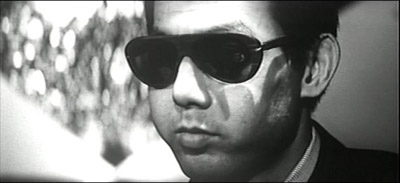
From some angles he looks normal, but from others he seems to be chewing on Kleenex. Hanada is the Number Three killer in the Yakuza (they're ranked, presumably by U.S. News and World Report). Early in the movie he kills numbers Four and Two. But after a botched hit, the Yakuza sends Number One to hunt him down. If that sounds like a pretty generic crime movie plot, it is. What makes the movie interesting are the bizarre details to the story.
For one thing, Branded To Kill is a fetishist's wet dream. The movie is crawling with people who replace their desire for one thing with something else. Hanada has an obsession with the smell of freshly boiled rice, and is constantly demanding that people prepare rice for him so he can smell it. Suzuki says in an interview on the disc that he thought this would be a good way to show that the killer was Japanese: he doesn't like the smell of steak or hamburgers but of rice. But he takes it for granted that the character would be obsessed with the smell of some type of food. I don't know if that's typically Japanese or not, but it's certainly weird. Hanada is also a fan of non-traditional sex; early in the movie is a five minute sequence of him sleeping with his wife in which variations of this shot:
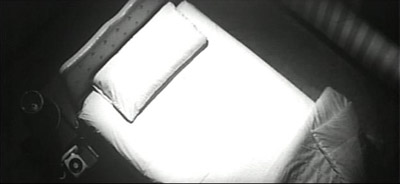
are intercut with variations of this shot:
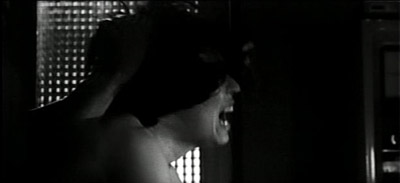
This movie has more sexual positions in that sequence than anything else I've seen except Wild At Heart. With a wife like that, you'd think he wouldn't stray, but he seems to find his wife a little too crazy. So it's no surprise that when he meets a nice, normal girl named Misako, he falls hard for her. They meet cute: he's on the way home after killing six or seven people and his car breaks down. She's driving a convertible with the top down in the rain, and offers him a ride. Here she is, looking as happy as she ever will:
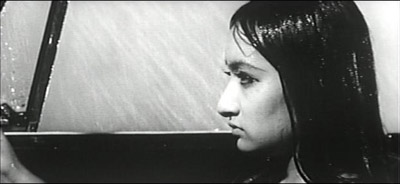
To me, the expression on her face is a warning sign. More worrying is her dashboard ornament:
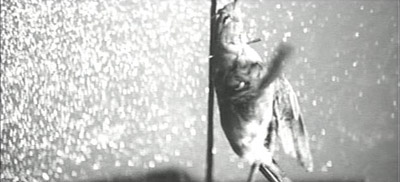
Yes, that's a dead bird with a spike driven through its neck, hanging from her rear-view mirror. Not only does Hanada not get out of the car when he notices this, he can't get her off his mind, and when she shows up offering him a job, he takes it. That's the job he blows, in a pretty literal illustration of the butterfly effect (a butterfly lands on the barrel of his rifle just as he pulls the trigger, causing him to miss). And things go downhill from there. Here's the most tender moment in his relationship with Misako:
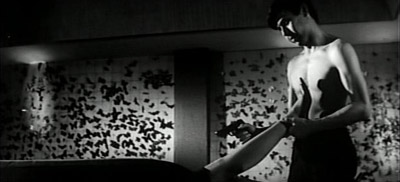
That's Misako's apartment, where the walls are decorated with pinned butterflies. Hanada keeps the gun trained on her while he takes off her shoes, then her stockings. Unfortunately, she gets her hands on the gun then and tries to shoot him. She misses. You would think the (at that point) second-highest ranked Yakuza killer would try to avoid a woman who'd just shot at him, but not Hanada; instead, he watches her put her stockings back on through a keyhole:
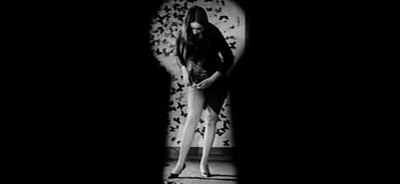
So yeah, this film has a kink or two. It's no secret that Japanese sexuality is pretty distinct from the American variety, but I haven't seen many movies that reflect that.
It's a mistake to focus much at all on the relationship between Hanada and Misako, though; this isn't a love story, and it's not what you'd call character-driven. It's also not what you'd call plot-driven; the story is pretty ridiculous. The movie's worth watching almost purely for its style. The stills above give some sense of the sort of late-sixties cool the movie exudes, but they can't convey the experience of Suzuki's truly unique and bizarre cinematic grammar. By grammar I mean the set of conventions he uses to convey information beyond what you see on screen. Everyone's familiar with the Western conventions, even if they don't know it: a slow push into someone's face usually means "this character is making an important decision," a dissolve indicates the passage of time, and so on. Most of these things are understood more or less subliminally, but when you run into a filmmaker who observes none of them, the results can be pretty jarring. I'm not sure if this is unique to him or if it is part of a national style, but I suspect it's just him, since this movie got him fired.
He does have his own set of rules, however, and although it takes multiple viewings to figure them out, it's kind of a fun project. He likes to rotate the camera around a subject in 90 degree increments when they're anguished, for example. He uses non-diagetic sound and shots that are unrelated to the action of a scene to convey subjective impressions. You can see this in the sex scene between Hanada and his wife; although the sudden cuts to shots of Misako make it look like she is watching, the sound of rain from earlier in the movie and the way Hanada covers his wife's face makes it clear that he is imagining he is sleeping with Misako instead of his wife. But for every technique that works, or makes a loopy kind of sense, there's one that doesn't, like mixing cell animation with film for one 20-second sequence, like so:
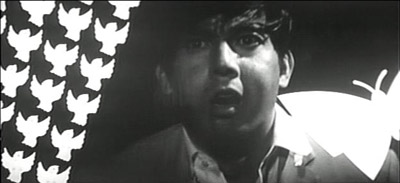
I'd be inclined to forgive this technique (it's certainly visually striking in a graphic-design kind of way) if it weren't for the fact that he only uses it once in the whole film, and it doesn't really tell us anything that hasn't been established over and over again by that point. I could be mistaken, but it also seemed to me that the last third or so of the movie (after Number One appears) was much less visually interesting, and had a lot of shots that I actively disliked: unmotivated camera moves, shots with peoples' heads cut out of frame, and at least one plot point (Number One seeming to burn his own face with acid in the bathroom for no reason) that I have been trying unsuccessfully to sort out since I saw the movie. I don't think the style is in service of anything throughout the film, and I think the style sort of falls apart towards the end. Without that, there's not much left to enjoy.
But when it is good, it is very very good, and some of Suzuki's techniques look better now than they would have in 1967. Take this, for example; Hanada is slowly crawling under a car that he's pulling forward as he moves toward some gunmen:
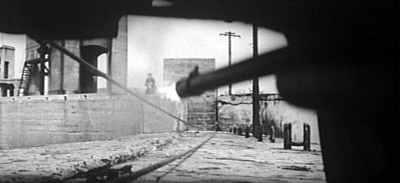
In the shot above, which is quite long and moves forward with the car, Seijun Suzuki has just invented the first-person shooter. I also loved the sequence where Hanada kills four diamond smugglers: the diamonds are being smuggled inside of glass eyes. Glass eyes that are being worn at the time. Anyway. This movie is a bit of work to decipher, but it's interesting. I'm curious to find out the extent to which Suzuki's techniques were picked up by other Japanese directors. And if you want an introduction to a kind of movie you've never seen before, you could do worse than to rent this. Until there's a Criterion edition of S.P.Q.R., of course.


13 comments:
Nice write-up -- I think you'll find Tokyo Drifter to be much more accessible. You won't hit any more Suzuki in the CC until you've watched a couple hundred more movies.
Thanks! I just finished my second viewing of Tokyo Drifter & will be writing about it soon. It seems like the work of a different director, almost.
I have to say that I love the glass eye smuggling idea.
Regarding FPS, don't you think that The Great Train Robbery was probably the first film to have FPS elements in it. (I do agree though that the creeping forward with the gun is much more closer to the true gameplay.)
Rog, you might not love the extreme close up of a glass eye being removed from an eye socket, however. And I could be wrong about whether they were smuggling the diamonds in the eyes, all I know is that one of the conspirators is an optomotrist who takes out a glass eye, takes it over to the sink, and is rinsing it when he's shot (through a drain-pipe, no less). I think you later see a glass eye that's been unscrewed into two halves, but I don't remember. W/R/T The Great Train Robbery, I've never seen it, but isn't the shot in that of an actor aiming a pistol directly at the camera? I was thinking more of the "floating gun in the foreground that you're holding" thing from Doom, but maybe that's in TGTR also? I should probably see that.
You'll encounter another early use of the first person shooter style in an upcoming Criterion selection: The Passion of Joan of Arc, believe it or not.
Wow; that's early. Looking forward to it.
I watched this movie last night after your write up because it intrigued me. I did notice most of what you were talking about and I agree that once #1 was in the picture, the movie slowed for me. Why did #1 hand out with #2 all the time? I was confused. Was he just toying with him to make it more fun?
I think Asian cinema in general does a great job using silence and nature sounds. I liked that whenever Misako was around it was pouring rain. However, I could not figure out whenever (literal) silence was used in the movie. I thought it was bad recording the first time that it happened. Have you seen Last Life in the Universe? The director Ratanaruang knows how to use silence where an American film would use Bon Jovi.
Two general comments:
1. You stopped putting recommendations on films? Was that for any reason?
2. I think your write ups are great, but in some you give away main plot points and/or the endings to the movie. Could you attach a "spoilers" tag to write ups where you do that? I really like reading your blog and it helps me understand the movie, but I lose almost all interest if I already know whats going to happen by the end. Thanks!
I meant, why did #1 HANG out with (the now) #2 all the time?
Joseph,
My impression was, yeah, that he was just toying with him. But that whole burnt-face thing didn't make any sense to me at all. I also liked the sound in the movie but I don't remember when it was silent. I haven't seen The Last Life In The Universe but it looks good from the IMDB comments; I'll check it out. Re your comments:
1. I stopped doing recommendations because I thought it was reductive. And there are movies that I like for some things but not others, or that I think are good if you like the genre but not good enough if you don't, and so on.
2. The only movie where I steered away from giving away anything was Diabolique. So for the most part, assume there will be spoilers. I try to write at least the opening parts of these assuming the reader knows nothing about the film. But as far as analyzing a film, I think structure's a big part of that (and the main thing I'm interested in learning about, cause I write); and you can't talk about that without looking at the whole movie. Re: losing interest if you know what's going to happen by then end, I'm with Nabokov on this. He said in one of his lectures that there's no such thing as a good reader, only a good rereader. & I think that's true of any narrative art form—the first time through, you can't see the ways the story works structurally, or where things are foreshadowed, &c. (For example, Chinatown is a completely different movie the second time you see it, because you know Faye Dunaway is going to get shot in the eye, and can appreciate all the sick jokes about that throughout the movie). Which is not to say I enjoy giving away secrets to movies, but is to say that knowing the ending isn't necessarily a disadvantage.
Anyway, larger point is, to write about the things that interest me in these movies, I usually have to include spoilers, which I hope don't detract too much from your experience watching any of the movies; if you read the opening paragraph of one of my write-ups and know you're going to want to see the movie, stop reading and come back to it later!
Good Call re: Coming back to a review later if it is something that would interest me. It was good to hear your personal strategy on reviews to figure out where you are coming from.
Which, brings back up the recommendation point. Is there some way to do a short "I liked this movie because of x,y, and z" in the beginning?
I realize I'm not your only reader and it is your blog so continue how you see fit. I felt like I understood BTK (Interesting initials, isn't it?) much better after reading your review than I would have had I just watched it on my own. And this review seemed to hold the balance of understanding and not giving away too much information, in my opinion.
I am using your blog as a tool to help me learn more about films that I wouldn't know anything about which enhances the viewing experience. Its an efficient (read: time saving) way to pick a good set of movies to watch. I will keep in mind your charge though. Thanks for the bloggin! It gives me something to do at work.
I'm glad to hear this is helpful to you as far as finding good movies. I kind of started watching all of these for the same reason; I didn't know enough to really know what to watch. So I figured that anything Criterion had chosen to release would have something to recommend it (and also knowing that, left to my own devices, I wouldn't choose to see most of these movies on my own).
My reaction to the first twenty minutes of Branded To Kill was pretty much WTF. But like the scene of an accident, Branded To Kill is oddly compelling and in its way very Samuel Fulleresque: it can be in turn beautiful, quite bizarre, or entirely incomprehensible. The last may be a problem of translation and my own cross-cultural ignorance, but as far as I can tell Branded To Kill is largely an example style over substance, which is not enough for me. I say that, but then I think about Warren Beatty’s Dick Tracy, a film I admire almost exclusively for its style. So perhaps it would be more accurate to say that in the specific case of Branded To Kill style does not compensate for a perceived lack of substance.
Criterion films do always have something to recommend them and Branded To Kill, for its style, is no exception. They also, for the most part, require repeat viewings to fully appreciate all they have to offer which makes me wonder whether it is ever fair to judge a film on the basis of a single viewing (with the possible exception of Tron Legacy).
Thank you for your post and review of Branded To Kill.
I can't wait to see this film.
Post a Comment